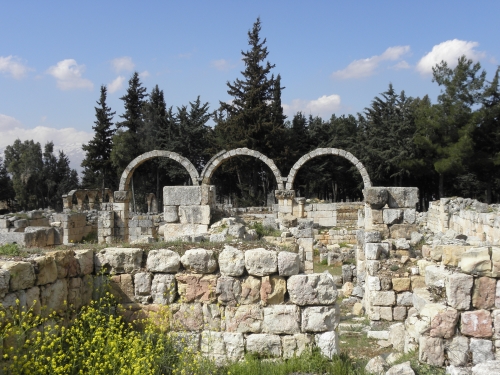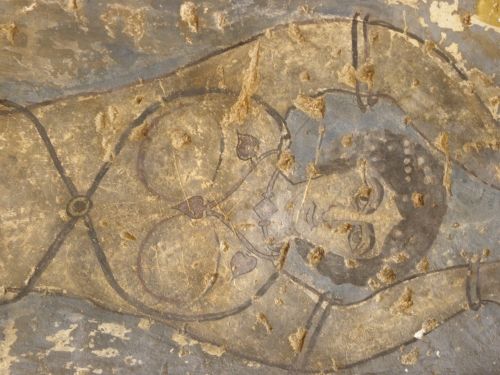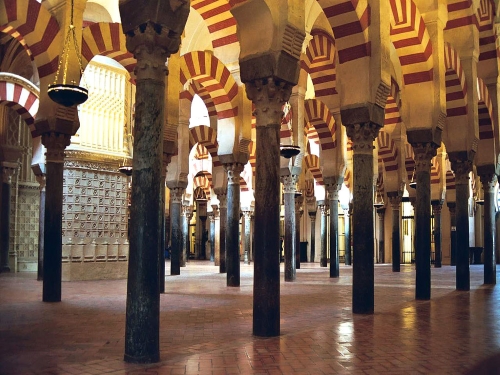Blog Connections
The Umayyads
I am currently preparing for a short trip to Medina Azahara. The OUV of this recent WHS in Andalucia is tied to both the “Umayyad cultural and architectural civilization” and “the significant period of the 10th century CE when the Umayyad caliphate of Cordoba was proclaimed in the Islamic West”. I found this is a good excuse to polish up our Umayyad Caliphate connection, as it actually falls apart into 3 focus areas: the original Umayyad empire, typical Umayyad art & architecture and the much later spin-off Umayyad caliphate of Cordoba.

The original Umayyads
The Umayyad Dynasty hailed from Mecca, but Syria was their main power base. Damascus was their capital from 661 to 744 and Harran (a TWHS) from 744 til 750.
Damascus was mainly a Christian city at the time. The Umayyads introduced an Islamic coinage system and established Arabic as the official language. They created a new urban plan with the Great Mosque (at the spot of the former Christian Cathedral of St. John) at its heart. This model served as an example to subsequent other Arab cities. The process of cultural Arabization and Islamization also extended to Jerusalem, where the Umayyad Caliph ordered the construction of the Dome of the Rock (692) .
The Umayyad sphere of influence reached from Central-Asia to the Iberian Peninsula, making it the third largest contiguous empire in the world. In Tunis and Kairouan they founded the city and built the Great Mosque. Akko and Tyre were important ports / naval bases and the Umayyads strengthened their fortifications. Now nothing tangible is left from the Umayyad period in these latter cities. Anjar and Aleppo are considered the best examples – after Damascus – of Umayyad town planning and city building.

Umayyad Architecture and Art
The art & architecture that the Umayyads created is considered to be a mix of other Middle Eastern civilizations and that of the Byzantine Empire. They also added own inventions such as mosques with minarets and the horseshoe arch.
In their architecture they often re-used existing buildings. In Syria, “churches were converted to mosques by blocking up the west door and making entrances in the north wall”.
The best example of Umayyad art undoubtedly is Quseir Amra. The frescoes in this bath house are a form of early Islamic art, far away from the “austere religious environment”.

The Umayyad caliphate of Cordoba
The 7th century Umayyad Dynasty had already reached unto what are now Spain and Portugal. It survived there even after the Umayyads lost their position in Damascus to the Abbasids. From 929 to 1031 they transformed into the Caliphate of Córdoba, which still was governed by a member of the Umayyad Dynasty. It had its capital in Córdoba. They secured Melilla, Ceuta and Tangier on the North African coast and held “diplomatic relations with Berber tribes in North Africa, Christian kings from the north, and with France, Germany and Constantinople.”
The Historic Centre of Córdoba is of course the most impressive testimony to this Caliphate of Cordoba. Here the focal point is the Great Mosque of Cordoba, built on the location of a Christian church just as the ‘original’ Umayyad Mosque of Damascus. Nearby Medina Azahara was its newly build twin city.
In total, 8 WHS attribute their OUV to the Umayyads in some form or another. 7 WHS have a lesser connotation.
Els - 17 March 2019
Comments
Caspar Dechmann 17 March 2019
That is very impressive for one family! Thanks!
Clyde 17 March 2019
Very interesting post, Els! Thanks
Els Slots 17 March 2019
Good find, Solivagant! I believe it was at least Umayyad in architectural style (see Data at https://archnet.org/sites/2730). It probably wasn't built on the orders of an Umayyad dignitary (Toledo seemed to have been "far" from Cordoba in that respect), but by a private person. And I'll remove Abassid.
Solivagant 17 March 2019
"In total, 8 WHS attribute their OUV to the Umayyads in some form or another. 7 WHS have a lesser connotation."
I see that we haven't connected Toledo to this Connection.
Crit iii for Toledo states "The civilisation of the Emirate of Cordoba built a great many Islamic art monuments...." and then lists a number including the Bab al- Mardum Mosque. This was built in 999 and became the Mosque of Cristo de la Luz.
But we have it connected to the Abbasid Caliphate !!?? If my reading of the history is correct - Toledo was frequently in a state of rebellion but "In 932, Abd al-Rahman III conquered Toledo, re-establishing control of al-Tagr al-Awsat, the Central March of the Omeyyad state" (Wiki). My "bible" on such matters - "Islamic Art and Architecture" (pub Konemann) clearly places the Bab al-Mardum mosque in the chapter on "Spanish Umayyads" - just before Medina al-Zahra!!
What is your understanding on this?